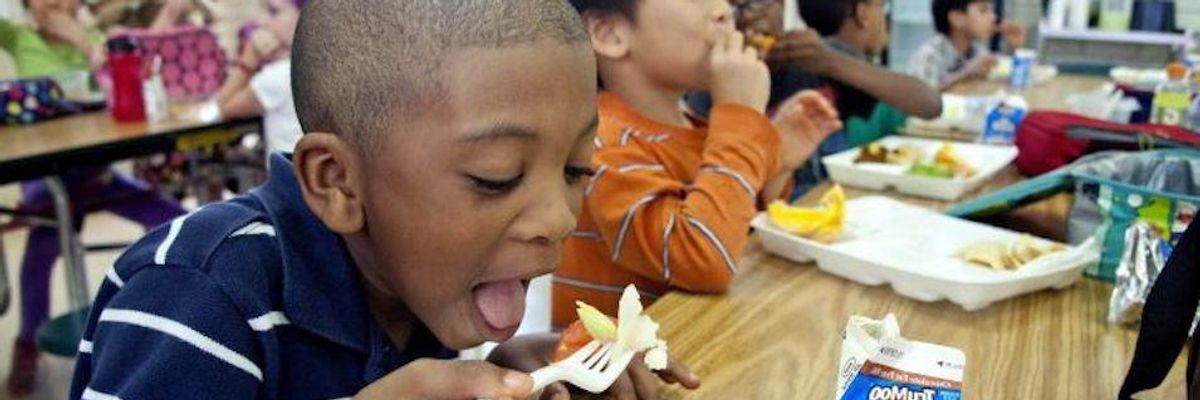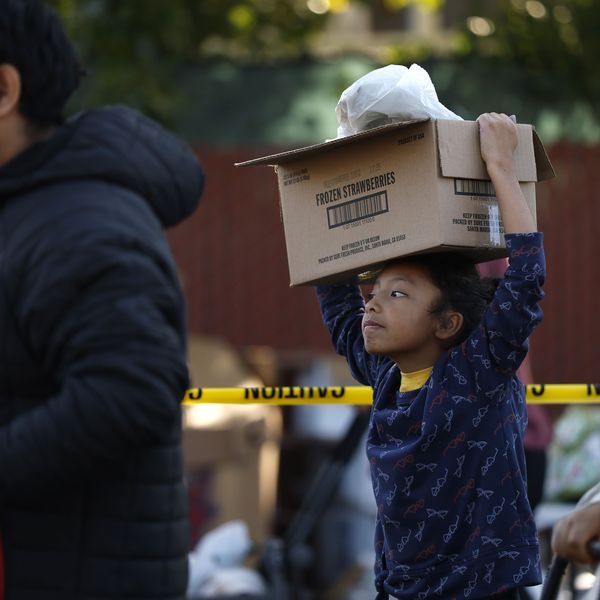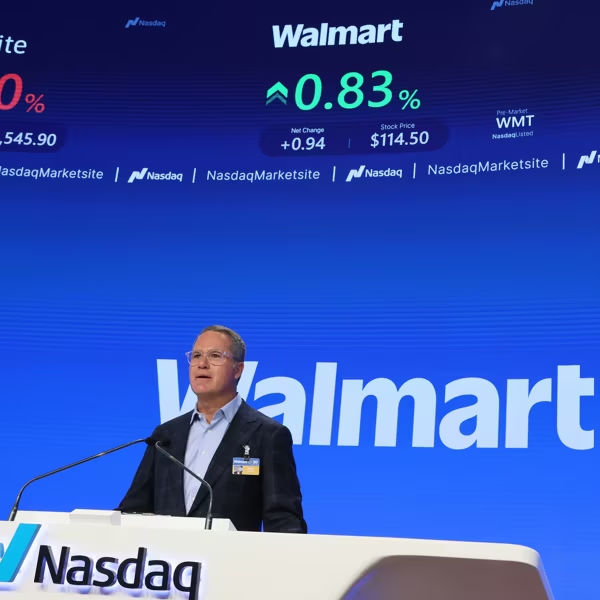
School lunch programs have been critical for feeding kids. (Photo: Amanda Mills/USCDCP)
US Kids Shouldn't Go to School Hungry
One might wonder why politicians would want to literally take healthy food out of the mouths of hungry school children
Nearly half of America's children live in low-income and poor families, and the majority of public school students qualify for free breakfast and lunch programs. Nearly 30 million children--more than the population of Texas -- benefit from the National School Lunch Program.
In low-income households, it's often food that gets sacrificed to pay rent, utilities, and health bills. Parents or older siblings will go without so the youngest can eat. Or cheap non-nutritious food may be the only affordable option.
School lunch programs, linked to household income and eligibility to receive Supplemental Nutrition Assistance Program (known as SNAP, or food stamps), have been critical for feeding kids. And the Healthy, Hunger-free Kids Act, which enjoyed bipartisan support when it passed in 2010, has made school lunches healthier by reducing sodium and saturated fats, and adding whole grains.
However, the Trump administration began a rollback of the nutrition standards in the Healthy, Hunger-free Kids Act over a year ago. And now, as part of a proposed new rule that would knock 3 million struggling families off SNAP, over half a million children would lose access to the free and reduced lunch program.
There's virtually no debate that kids need nutritious food to stay healthy and learn at school. Numerous and broad studies have shown that school meal programs reduce obesity, poor health and food insecurity.
So one might wonder why politicians would want to literally take healthy food out of the mouths of hungry school children. Great question.
The rollback of nutrition standards, for starters, appears to be a naked giveaway to the dairy industry, which complained that their profits were affected when school meals started cutting back on saturated fat.
For the school lunch cuts, the Trump administration is using the phony justification that SNAP is rife with fraud. In reality, advocates say SNAP hasthe most rigorous standards of any federal program. Less than 1 percent of SNAP spending is estimated to be fraudulent--likely much lower than the Pentagon, which can't pass an audit, yet whose far bigger budget Trump keeps increasing.
This proposed rule change seems a barely veiled attempt to take more money from effective safety net programs for those in need--while no expense is spared to ensure the extremely wealthy get tax breaks.
"If you are human, please continue to feed other humans," writes Houston, Texas resident Kaura Webb. Former school teacher Barbara McCarty from Palm Desert California says, "Do NOT diminish this vital program for OUR families in need. As a former school teacher and mother, I know personally how important nutrition is for young minds to grow."
Seventy mayors also sent a letter to the Trump administration chastising it for this proposed change.
They point out that "this far-reaching executive action will escalate food insecurity and hunger for an estimated 3.1 million individuals--including children, seniors, and people with disabilities." It will also "put children's health and development at risk" and "harm our economy by reducing the amount of SNAP dollars available to spur regional and local economic activity."
As children head back to school this year, at the very least they deserve access to hot and nutritious meals. It's a moral imperative. There should be no other choice in the wealthiest country in the world.
An Urgent Message From Our Co-Founder
Dear Common Dreams reader, The U.S. is on a fast track to authoritarianism like nothing I've ever seen. Meanwhile, corporate news outlets are utterly capitulating to Trump, twisting their coverage to avoid drawing his ire while lining up to stuff cash in his pockets. That's why I believe that Common Dreams is doing the best and most consequential reporting that we've ever done. Our small but mighty team is a progressive reporting powerhouse, covering the news every day that the corporate media never will. Our mission has always been simple: To inform. To inspire. And to ignite change for the common good. Now here's the key piece that I want all our readers to understand: None of this would be possible without your financial support. That's not just some fundraising cliche. It's the absolute and literal truth. We don't accept corporate advertising and never will. We don't have a paywall because we don't think people should be blocked from critical news based on their ability to pay. Everything we do is funded by the donations of readers like you. Will you donate now to help power the nonprofit, independent reporting of Common Dreams? Thank you for being a vital member of our community. Together, we can keep independent journalism alive when it’s needed most. - Craig Brown, Co-founder |
Nearly half of America's children live in low-income and poor families, and the majority of public school students qualify for free breakfast and lunch programs. Nearly 30 million children--more than the population of Texas -- benefit from the National School Lunch Program.
In low-income households, it's often food that gets sacrificed to pay rent, utilities, and health bills. Parents or older siblings will go without so the youngest can eat. Or cheap non-nutritious food may be the only affordable option.
School lunch programs, linked to household income and eligibility to receive Supplemental Nutrition Assistance Program (known as SNAP, or food stamps), have been critical for feeding kids. And the Healthy, Hunger-free Kids Act, which enjoyed bipartisan support when it passed in 2010, has made school lunches healthier by reducing sodium and saturated fats, and adding whole grains.
However, the Trump administration began a rollback of the nutrition standards in the Healthy, Hunger-free Kids Act over a year ago. And now, as part of a proposed new rule that would knock 3 million struggling families off SNAP, over half a million children would lose access to the free and reduced lunch program.
There's virtually no debate that kids need nutritious food to stay healthy and learn at school. Numerous and broad studies have shown that school meal programs reduce obesity, poor health and food insecurity.
So one might wonder why politicians would want to literally take healthy food out of the mouths of hungry school children. Great question.
The rollback of nutrition standards, for starters, appears to be a naked giveaway to the dairy industry, which complained that their profits were affected when school meals started cutting back on saturated fat.
For the school lunch cuts, the Trump administration is using the phony justification that SNAP is rife with fraud. In reality, advocates say SNAP hasthe most rigorous standards of any federal program. Less than 1 percent of SNAP spending is estimated to be fraudulent--likely much lower than the Pentagon, which can't pass an audit, yet whose far bigger budget Trump keeps increasing.
This proposed rule change seems a barely veiled attempt to take more money from effective safety net programs for those in need--while no expense is spared to ensure the extremely wealthy get tax breaks.
"If you are human, please continue to feed other humans," writes Houston, Texas resident Kaura Webb. Former school teacher Barbara McCarty from Palm Desert California says, "Do NOT diminish this vital program for OUR families in need. As a former school teacher and mother, I know personally how important nutrition is for young minds to grow."
Seventy mayors also sent a letter to the Trump administration chastising it for this proposed change.
They point out that "this far-reaching executive action will escalate food insecurity and hunger for an estimated 3.1 million individuals--including children, seniors, and people with disabilities." It will also "put children's health and development at risk" and "harm our economy by reducing the amount of SNAP dollars available to spur regional and local economic activity."
As children head back to school this year, at the very least they deserve access to hot and nutritious meals. It's a moral imperative. There should be no other choice in the wealthiest country in the world.
Nearly half of America's children live in low-income and poor families, and the majority of public school students qualify for free breakfast and lunch programs. Nearly 30 million children--more than the population of Texas -- benefit from the National School Lunch Program.
In low-income households, it's often food that gets sacrificed to pay rent, utilities, and health bills. Parents or older siblings will go without so the youngest can eat. Or cheap non-nutritious food may be the only affordable option.
School lunch programs, linked to household income and eligibility to receive Supplemental Nutrition Assistance Program (known as SNAP, or food stamps), have been critical for feeding kids. And the Healthy, Hunger-free Kids Act, which enjoyed bipartisan support when it passed in 2010, has made school lunches healthier by reducing sodium and saturated fats, and adding whole grains.
However, the Trump administration began a rollback of the nutrition standards in the Healthy, Hunger-free Kids Act over a year ago. And now, as part of a proposed new rule that would knock 3 million struggling families off SNAP, over half a million children would lose access to the free and reduced lunch program.
There's virtually no debate that kids need nutritious food to stay healthy and learn at school. Numerous and broad studies have shown that school meal programs reduce obesity, poor health and food insecurity.
So one might wonder why politicians would want to literally take healthy food out of the mouths of hungry school children. Great question.
The rollback of nutrition standards, for starters, appears to be a naked giveaway to the dairy industry, which complained that their profits were affected when school meals started cutting back on saturated fat.
For the school lunch cuts, the Trump administration is using the phony justification that SNAP is rife with fraud. In reality, advocates say SNAP hasthe most rigorous standards of any federal program. Less than 1 percent of SNAP spending is estimated to be fraudulent--likely much lower than the Pentagon, which can't pass an audit, yet whose far bigger budget Trump keeps increasing.
This proposed rule change seems a barely veiled attempt to take more money from effective safety net programs for those in need--while no expense is spared to ensure the extremely wealthy get tax breaks.
"If you are human, please continue to feed other humans," writes Houston, Texas resident Kaura Webb. Former school teacher Barbara McCarty from Palm Desert California says, "Do NOT diminish this vital program for OUR families in need. As a former school teacher and mother, I know personally how important nutrition is for young minds to grow."
Seventy mayors also sent a letter to the Trump administration chastising it for this proposed change.
They point out that "this far-reaching executive action will escalate food insecurity and hunger for an estimated 3.1 million individuals--including children, seniors, and people with disabilities." It will also "put children's health and development at risk" and "harm our economy by reducing the amount of SNAP dollars available to spur regional and local economic activity."
As children head back to school this year, at the very least they deserve access to hot and nutritious meals. It's a moral imperative. There should be no other choice in the wealthiest country in the world.

